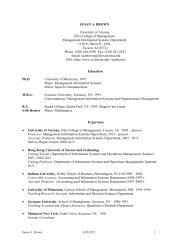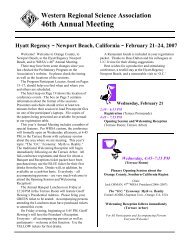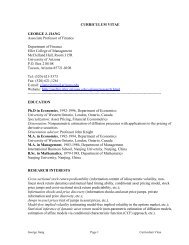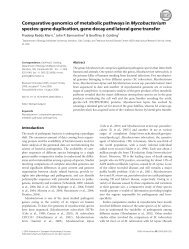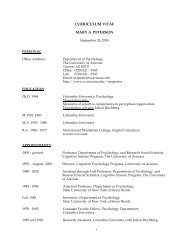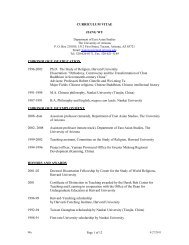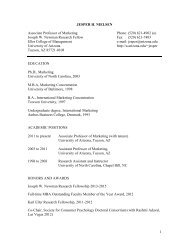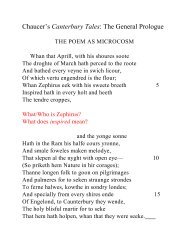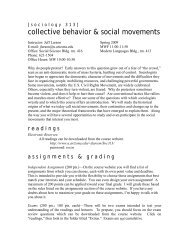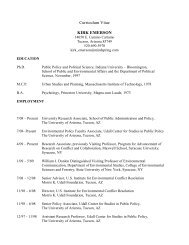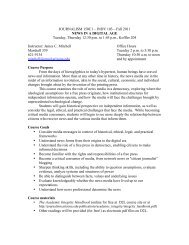Inter simple sequence repeat (ISSR) polymorphism and its ...
Inter simple sequence repeat (ISSR) polymorphism and its ...
Inter simple sequence repeat (ISSR) polymorphism and its ...
You also want an ePaper? Increase the reach of your titles
YUMPU automatically turns print PDFs into web optimized ePapers that Google loves.
11<br />
AFLP <strong>and</strong> microsatellite analysis with the universality<br />
of RAPD. <strong>ISSR</strong>s have high reproducibility possibly<br />
due to the use of longer primers (16–25 mers) as compared<br />
to RAPD primers (10- mers) which perm<strong>its</strong> the<br />
subsequent use of high annealing temperature (45–<br />
60 ◦ C) leading to higher stringency. The studies on<br />
reproducibility show that it is only the faintest b<strong>and</strong>s<br />
that are not reproducible. About 92–95% of the scored<br />
fragments could be <strong>repeat</strong>ed across DNA samples of<br />
the same cultivar <strong>and</strong> across separate PCR runs when<br />
detected using polyacrylamide (Fang & Roose, 1997;<br />
Moreno et al., 1998). 10 ng template DNA yielded<br />
the same amplification products as did 25 or 50 ng<br />
per 20µl PCR reaction. The annealing temperature<br />
depends on the GC content of the primer used <strong>and</strong><br />
usually ranges from 45 to 65 ◦ C.<br />
<strong>ISSR</strong>s segregate mostly as dominant markers following<br />
<strong>simple</strong> Mendelian inheritance (Gupta et al.,<br />
1994; Tsumura et al., 1996; Ratnaparkhe et al., 1998;<br />
Wang et al., 1998). However, they have also been<br />
shown to segregate as co-dominant markers in some<br />
cases thus enabling distinction between homozygotes<br />
<strong>and</strong> heterozygotes (Wu et al., 1994; Akagi et al., 1996;<br />
Wang et al., 1998; Sankar & Moore, 2001).<br />
Source of variability / <strong>polymorphism</strong><br />
The evolutionary rate of change within microsatellites<br />
is considerably higher than most other types of DNA,<br />
so the likelihood of <strong>polymorphism</strong> in these <strong>sequence</strong>s<br />
is greater. The source of variability in the <strong>ISSR</strong>s can<br />
be attributed to any one of the following reasons or<br />
any combination of these.<br />
(a) Template DNA<br />
Slippage of DNA polymerase during DNA replication<br />
<strong>and</strong> failure to repair mismatches is considered<br />
as a mechanism for creation <strong>and</strong> hypervariability of<br />
SSRs (Levinson & Gutman, 1987). Mutations at<br />
the priming site i.e. SSR could prevent amplification<br />
of a fragment, as also in RAPD markers <strong>and</strong><br />
thus give a presence/absence <strong>polymorphism</strong>. An insertion/deletion<br />
event within the SSR region or the<br />
amplified region would result in the absence of a<br />
product or length <strong>polymorphism</strong>, depending on the<br />
amplifiability of the resulting fragment size. Variability<br />
in number of nucleotides within a microsatellite<br />
<strong>repeat</strong> would result in length <strong>polymorphism</strong>s when<br />
using a 5’-anchored primer.<br />
(b) Nature of primer used<br />
The extent of <strong>polymorphism</strong> also varies with the<br />
nature (unachored, 3’-anchored, or 5’-anchored) <strong>and</strong><br />
<strong>sequence</strong> of the <strong>repeat</strong>s (motif) in the primer employed.<br />
When unanchored i.e only the SSRs are used<br />
as primers, the primer tends to slip within the <strong>repeat</strong><br />
un<strong>its</strong> during amplification leading to smears instead<br />
of clear b<strong>and</strong>s (Figure 1a). Extending the primer (anchoring)<br />
with 1 to 4 degenerate nucleotides at the 3’<br />
end (Figure 1b) or 5’ end (Figure 1c) assures annealing<br />
only to the ends of a microsatellite in template<br />
DNA thus obviating internal priming <strong>and</strong> smear formation.<br />
Secondly, the anchor allows only a subset of<br />
the microsatellites to serve as priming sites. When<br />
5’ anchored primers are used, the amplified products<br />
include the microsatellite <strong>sequence</strong>s <strong>and</strong> their length<br />
variations across a genome <strong>and</strong> therefore give more<br />
number of b<strong>and</strong>s <strong>and</strong> a higher degree of <strong>polymorphism</strong>.<br />
Usually di-nucleotide <strong>repeat</strong>s, anchored either<br />
at 3’ or 5’ end reveal high <strong>polymorphism</strong> (Blair et<br />
al., 1999; Joshi et al., 2000; Nagaoka & Ogihara,<br />
1997). The primers anchored at 3’ end (Figure 1b)<br />
give clearer b<strong>and</strong>ing pattern as compared to those<br />
anchored at 5’ end (Tsumura et al., 1996; Blair et al.,<br />
1999; Nagaoka & Ogihara, 1997). Since the primer<br />
is a SSR motif the frequency <strong>and</strong> distribution of the<br />
microsatellite <strong>repeat</strong> motifs in different species also<br />
influence the generation of b<strong>and</strong>s. There is a difference<br />
of abundance of SSRs between nuclear <strong>and</strong> organelle<br />
DNA <strong>sequence</strong>s. Taking di- <strong>and</strong> tri-nucleotides<br />
together, one SSR was found every 33Kb in nuclear<br />
DNA compared to every 423-Kb of organelle DNA<br />
<strong>sequence</strong> (Wang et al., 1994). In general, primers<br />
with (AG), (GA), (CT), (TC), (AC), (CA) <strong>repeat</strong>s<br />
show higher <strong>polymorphism</strong> than primers with other<br />
di-, tri- or tetra-nucleotide <strong>repeat</strong>s. (AT) <strong>repeat</strong>s are the<br />
most abundant di-nucleotides in plants but the primers<br />
based on (AT) would self- anneal <strong>and</strong> not amplify. Tri<strong>and</strong><br />
tetra-nucleotides are less frequent <strong>and</strong> their use in<br />
<strong>ISSR</strong>s is lesser than the di-nucleotides. The (AG) <strong>and</strong><br />
(GA)basedprimershavebeenshowntoamplifyclear<br />
b<strong>and</strong>s in rice (Blair et al., 1999; Joshi et al., 2000;<br />
Reddy et al., 2000; Sarla et al., 2000), trifoliate orange<br />
(Fang et al., 1997), Douglas fir <strong>and</strong> sugi (Tsumura<br />
et al., 1996) <strong>and</strong> chickpea (Ratnaparkhe et al., 1998),<br />
whereas primers based on (AC) di-nucleotide <strong>repeat</strong>s<br />
were found more useful in wheat (Nagaoka & Ogihara,<br />
1997; Kojima et al., 1998) <strong>and</strong> potato (McGregor et<br />
al., 2000). Resolving power Rp is an index developed<br />
to compare the value of different primers in terms



